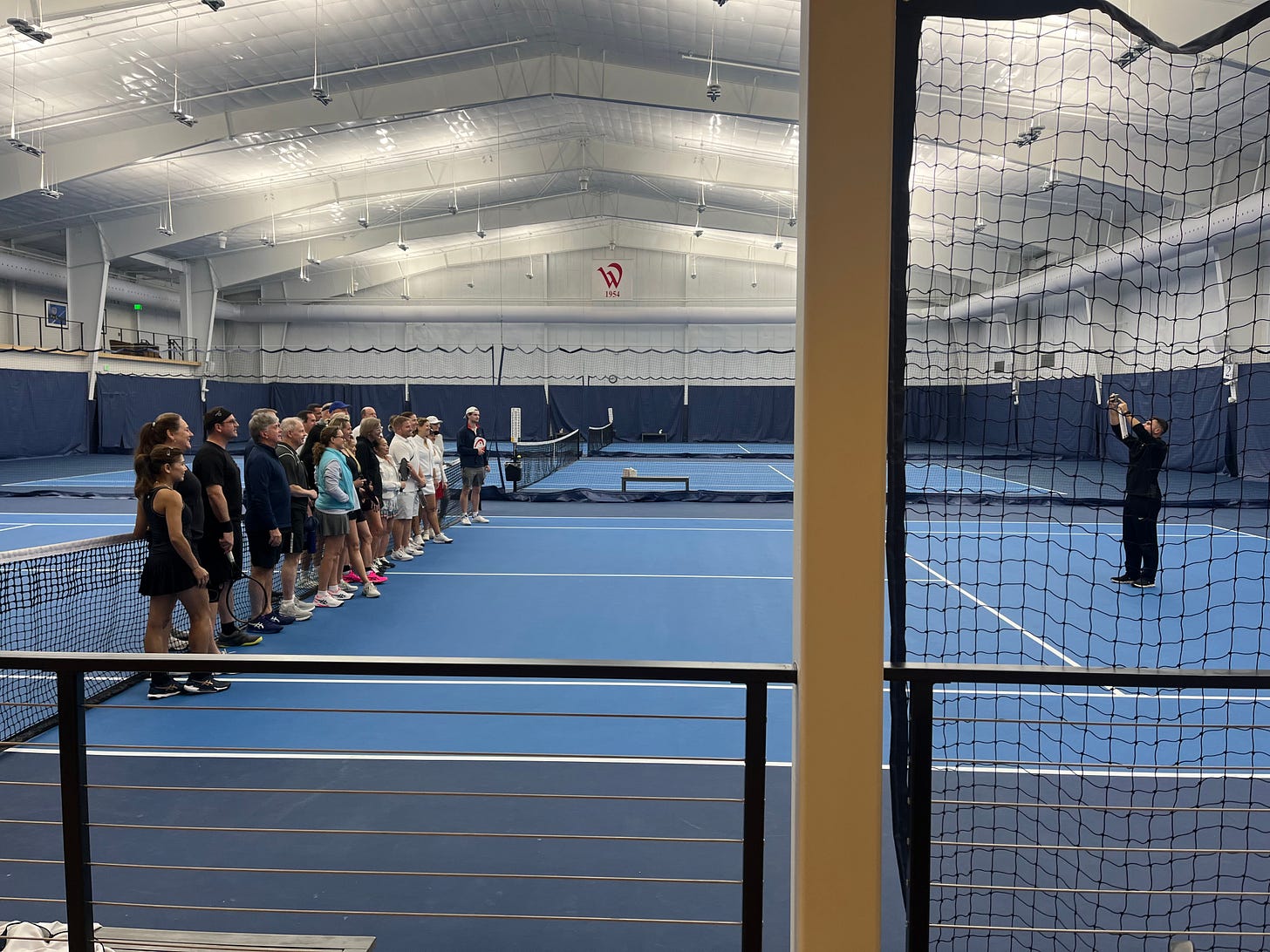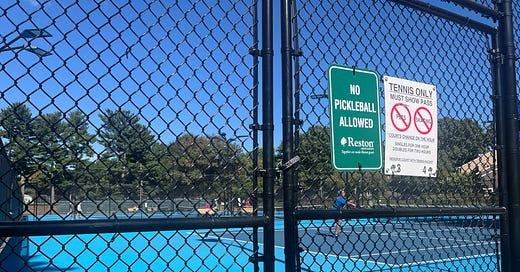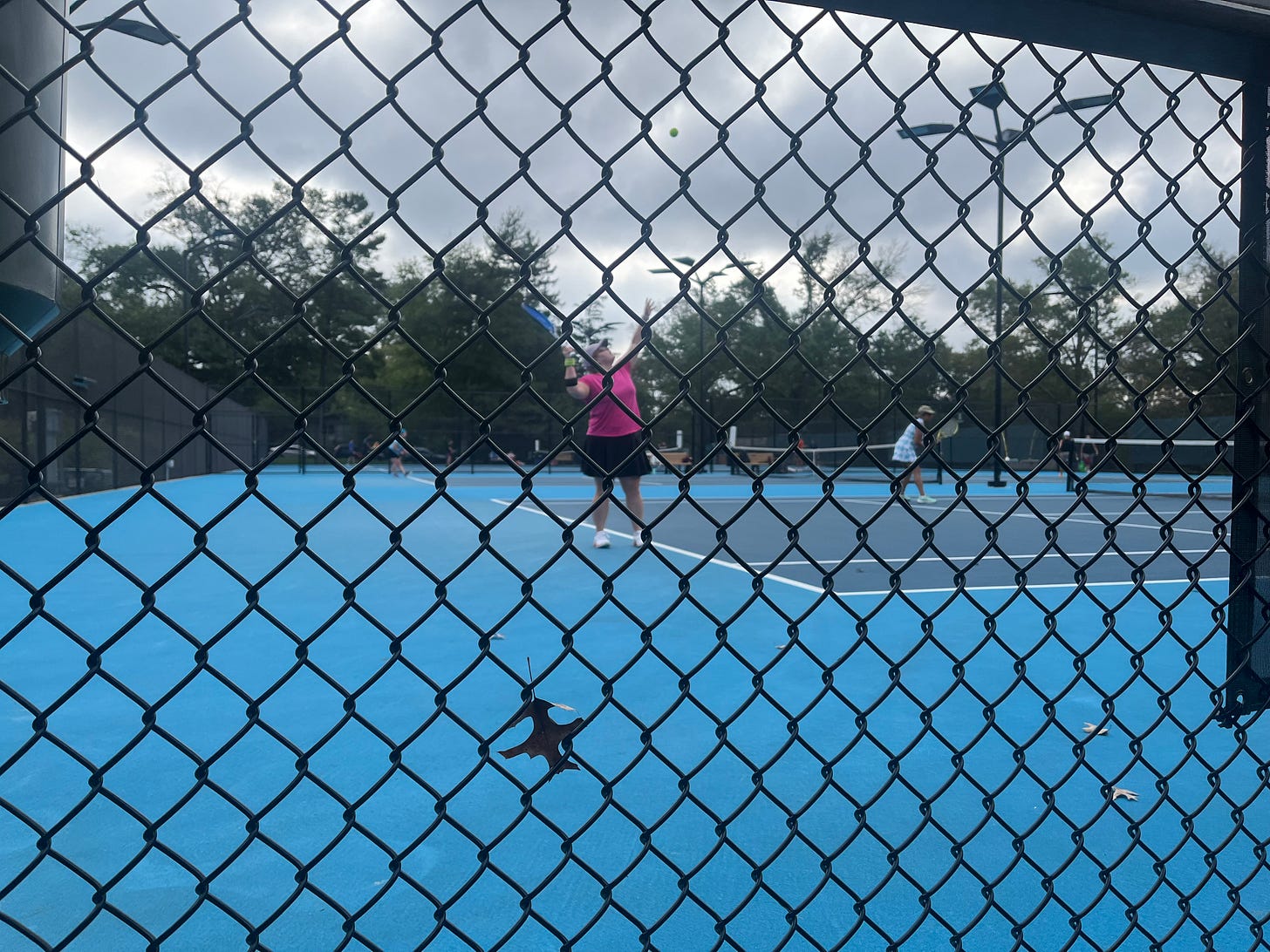Breaks in the tennis-pickleball war
The dueling sports both keep growing. Can experiments underway in Fairfax help them coexist?
They’re fist-fighting in the condo associations of Florida. They’re repainting courts illegally in Grand Rapids and spilling oil on them in California and cutting down nets in the suburbs of Boston.
And here in Virginia’s largest county, as tennis and pickleball players battle for space across a country divided by much more than court lines, they’re assembling every Wednesday at Westwood Country Club to—
Wait. Was that a fist bump?
“Good luck, play well and have some fun,” Dai Edwardes-Evans, the Vienna club’s director of racquets, told players from both sports as they clapped it up at center court one recent week. In this multisport league he has “pioneered,” tennis and pickleball players are on the same teams for a change. They earn points for winning matches in whichever sport they play. They have to root for each other by design. Then, at the end of the night, they all grab a drink together.
Tennis and pickleball “have got to be able to coexist,” Edwardes-Evans said, and Westwood’s league is one corner of a larger effort underway in racquet-sport-happy Fairfax County to help make that happen. It’s an effort that involves ramping up building and programming, some imagination, and a heap of work. It also involves compromise.
Since 2020, when pickleball took off, at least 10% of American tennis courts have been converted for it, according to the U.S. Tennis Association (USTA). In Fairfax, the Park Authority has invested around $2.4 million to add 60 public pickleball courts.
“Around here, it is just huge. I can’t even explain it,” said Chandra Soucek, of Vienna, who played pickleball at Westwood that night and travels to play events on the sport’s senior pro tour. “They’re lining courts everywhere. Forget the lines: They’re building permanent courts everywhere.”
The solutions might be simple — convert more courts, reorient more resources — if pickleball was killing tennis here.
They’re more complicated because it isn’t.
I. Growing numbers and programming
Just as people discovered pickleball during the pandemic, many “rediscovered” tennis at the same socially distanced time, said Jim Elder, a Reston tennis pro since 1997 who’s now president of the Northern Virginia Tennis League. U.S. participation shot up by 22% in 2020, according to the USTA, representing about 4 million additional players.
“Reston’s numbers went through the roof,” said Rob Tucker, Reston Association’s tennis and pickleball program manager. “We were beating our number by like 30%.”

Fairfax County courts have stayed busy since. This spring, the blockbuster “Challengers” made tennis look “cool” to viewers like recent L.A. transplant Lana Nelson, 22, who signed up for a Fairfax social league. This summer, for the first time in its 33-year history, the Washington Area Tennis Association launched a Northern Virginia league, in Annandale. Then, at the U.S. Open, young American stars gifted tennis fresh advertising.
People “will emulate what’s hot, what’s popular — and tennis is hot. Tennis is popular. Movies about tennis are popular,” said Pierre Rodgers, an associate professor at George Mason who teaches on the intersection of sports and culture. “Seeing this new generation of players of young professionals, from Coco [Gauff] to Naomi [Osaka], these are names that are starting to resonate.”
Reston, an early planned community whose tennis courts moved in before its first residents did, is finding interest in the sport today all the way down to its lowest age levels. It’s fostering it as well.
Tucker estimated that the U.S. has around 300 36-foot tennis courts, which are specially designed for young kids to learn the game; Reston’s built six of them. To ensure “the sport’s growing in all financial sectors,” he said, Reston Association partners with a nonprofit to provide free lessons and rackets to young players in financial need. And RA’s tennis lessons for 3- to 8-year-olds “consistently sell out.”
“They’re our most popular programs, and that’s how we're judging the growth of the sport: Are our young kids participating? And yes, they are,” Tucker said.
[Time Machine: How Big Oil saved Reston’s radical vision]
For the older set, Reston revived its Simon Cup tennis tournament in recent years, opened up clay courts in September at Glade Park that Tucker calls “some of the nicest courts on the East Coast” and is building courts in south Reston that he says should open next spring.
But the town is boosting pickleball at the same time. RA started pickleball programming in 2019, and its Autumnwood courts have since become a magnet for area players. The sport’s easier to jump into and play than tennis, so part of the draw is that players don’t need to buy lessons; they mostly just want places to play, Tucker said, without confusing restrictions.
Kathy Whittington, an Autumnwood regular, plays pickleball five days a week in retirement, after a back injury led her to convert from tennis’s greater grind. She likes playing in the morning, found Reston’s courts to be “jammed” at night. “They’ve been begging [for more courts] in Reston, but it’s the noise factor,” she said.
As is, the sport’s broader community has come to appreciate Reston. More than 200 people signed up — some journeying from Vermont or North Carolina — for a pair of “Paddle Battle” tournaments it held after the pandemic. The draw so overloaded RA’s software that it shifted to running smaller, more frequent tournaments instead, including one last weekend.
So, while Tucker said friends of his around the country are “miserable” and “hating life” as they struggle to please both sides, the Reston formula is mostly working.
“We're just very unique in that we have enough facilities to juggle both sports, keep them growing and make people happy,” he said, “which is my job.”
II. Bringing sports together
Before taking his Westwood job in 2022, Edwardes-Evans was head tennis professional at Washington Golf and Country Club, in Arlington, where he first “saw how pickleball was going to go,” he said. He got certified by top doubles player Collin Johns and, as he recounted, “grew the Washington Golf pickleball program from basically nothing to having 64 players come every two weeks just to play.”
In Westwood, Edwardes-Evans joined a club that was mid-construction on a new racquets facility. Its centerpiece was one of only 54 courts in the world for court tennis, the original royal version of the sport. (Prince Edward, Duke of Edinburgh, flew in for the court’s November 2022 ribbon-cutting.)

Edwardes-Evans, who grew up in Johannesburg and played college tennis in Alabama and Oklahoma, spent the start of his Westwood tenure putting the best staff he could in place. Soon, pickleball time slots started booking up on its dual-lined courts within minutes of opening; tennis lesson revenue beat expectations by some 50%.
“Tennis will always be No. 1” at the club, he said. “However, they’ve had to give up a little bit of their power in order to help grow our membership and allow them to play their pickleball or do whatever, as long as it doesn’t impact too much with the tennis courts.”
Many players play both, but he observed that, at Westwood, members often siloed themselves by whichever racquet sport they chose first. He and court-tennis pro Ivan Ronaldson spent two weeks over the summer devising a league that would bring together all of the club’s three. They spent hours just tweaking the scoring system, in part to incentivize intersport unity.
“My first week, I had three or four directors reach out to me across the country, saying, ‘Man, this is awesome. How did you do it?’”
One key idea: The eight-week league’s $15-a-night fee includes a drink at the mezzanine-level bar, overlooking the tennis courts. People stick around.
“And now I’m starting to see the pickleball community starting to get to know the tennis community, so it’s kind of a cool bonding experience,” Edwardes-Evans said. “… My first week, I had three or four directors reach out to me across the country, saying, ‘Man, this is awesome. How did you do it?’”
They had planned for just two teams — his Midnight Strikers and the Ronaldson-led White Lightning — and then got more than a hundred sign-ups. Next year, they’ll split into four teams instead.
Soucek, the pickleball player, thinks the league is “a hit.” A former tennis player and teacher stateside and abroad, she said “there’s no reason why” tennis and pickleball shouldn’t coexist. When The Machine mentioned tennis players’ concerns about re-lining courts for pickleball, she interjected to say: “Underutilized courts.”
“There are parts of tennis, I guess, that will be hurt by it, but I don’t think in a way that’s significant, because I think it comes down to what’s affordable,” Soucek said. “Tennis is just not affordable for some people, and pickleball is, and that is not going to change.”
One of the area’s friction points has been Glyndon Park, two streets away from Westwood. Last year, after a backlash over noise, the Vienna Town Council cut back on pickleball hours and days there. Some players have given up on the park since, Soucek said, and she would have preferred shortening hours further rather than taking away certain days.
“But I agree with making a compromise,” she said.
III. Building and advocating
After adding the 60 new pickleball courts, Fairfax County’s Park Authority now operates 195 tennis courts and 88 pickleball courts in all. An additional project at Annandale’s Wakefield Park, which will start in the spring, will convert one more tennis court into four pickleball courts, add two new pickleball courts and make a dual-lined court tennis-only. Ben Boxer, the Park Authority’s public information officer, called it a “win-win for both the tennis and pickleball communities.”
Jorge Torrico, one of tennis’s most creative proponents in Fairfax County, believes more win-wins are possible. A government contractor who lives in Burke, Torrico dove into the sport with his family three years ago. Since then, he’s started a nonprofit called Burke Tennis Club to run low-cost youth tournaments and push for more and better-maintained courts.
[10-ish Questions: A month of fatal pedestrian crashes — and a month to prevent more]
But he also started a Facebook group called “New Burke Pickleball Club,” which he said he sent to every other pickleball group within 100 miles to get them to join. Its mission, though he doesn’t play the sport, is to advocate for new pickleball courts in new spots, like in the parking lot at the Rolling Valley Park and Ride.
“I will always support new pickleball construction. Always,” said Torrico, 44. “But I will not support taking away from tennis.”

Last month, he posted on his page about the construction of the Down the Line pickleball center in Annandale. “This is ultimately the solution for pickleball fans” and business owners, Torrico wrote.
Down the Line owner Jenni Bae might tell you it’s not that simple.
“In this area in particular, it is insanely expensive not just to own but to rent,” she said in a phone interview. “… It is not a lucrative business unless you work really hard at making it a very successful center.”
Unlike with golf or tennis, people are used to playing pickleball for free. And as more centers open, Bae said, “we’re facing a little bit of saturation in terms of places that you can go, particularly indoors.”
Those pickleball options might ease some of the pressure on Fairfax County to add further public courts. But Bae says the local demand still outstrips court supply — and is still rising.
“For me,” she said, “even as a business owner, I think the more courts the better.”
IV. Teaming up
That Wednesday night at Westwood, the pickleball players wrapped their matches first like usual, and they and their scores trickled in to the mezzanine level.
The first group of four men came through a few minutes before 8 p.m., grabbed drinks from the bar, and bantered about their games as they tuned in to a tennis match unfolding below. “Come on, Tom!” one shouted.
More players followed, and Edwardes-Evans recorded their news with both professional enthusiasm and open Midnight Strikers partisanship.
“Nina, did you win? There we goooo.”
“Lisa, how did you guys do? Oh, it’s okay. Oh, close!”
Amy Thompson reported her own pickleball win that night. Thompson, 37, played tennis in college, taught it afterward and plays it almost every day at Westwood, so she doesn’t identify as a pickleball player. But she does routinely play that, too, including with “a bunch of moms” after school drop-off at Our Lady of Good Counsel.
She’s good enough at pickleball, in fact, that one week at the trisport league a couple newbies asked her to teach them. She agreed, and they got a group of eight people and all played together. It was fun, she said.
“But do I think pickleball should take over a tennis court? No,” Thompson said. “The fad needs to stay longer before they start doing that.”
An end to the war? It’s not here yet.








Great article, informative and well-written.